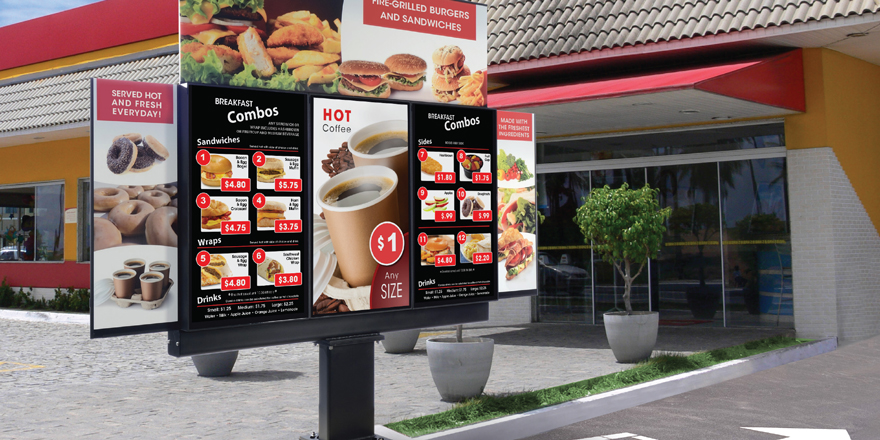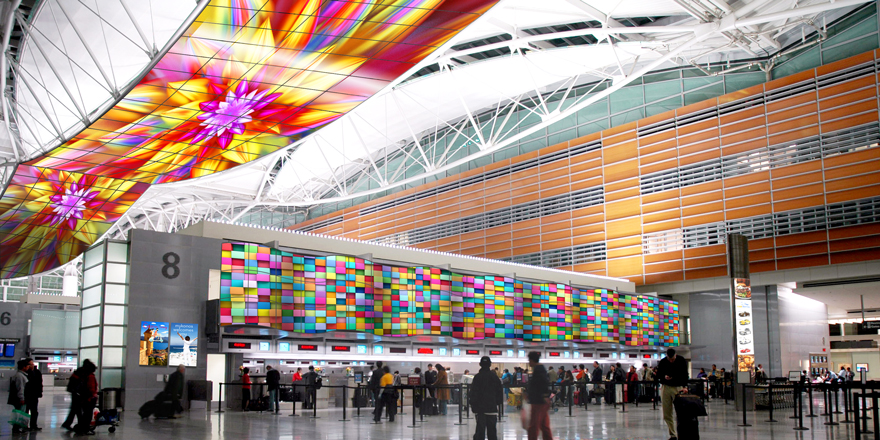
Last week we touched on what’s happening with digital signage in the QSR industry. This week we’ll get into the benefits digital signage is bringing to QSRs, regardless of the size of the restaurant or the number of restaurants in the chain.
Enhanced Customer Experiences
Perhaps the biggest benefit of digital signage for a QSR is speed. When customers can clearly see bright, well-organized menus and promotional content, along with high-resolution images of the food items, they can more easily make their decisions on the spot. This helps keep the lines moving so customers can get their orders quicker, enjoy their meal and get back to their day. Another benefit is a reduction in perceived wait time – by displaying entertaining content, such as video clips, customers are given something to do while they wait in line or at the table.
Self-order kiosks with touch screen displays also improve the customer experience. Customers do not have to wait in line, ordering accuracy is virtually guaranteed, loyalty apps can be scanned and service is quickened. Self-order kiosks can also help increase sales as they recommend additional items during the ordering process.
Effective Advertising
Digital menu boards and promotional displays can deliver marketing messages efficiently and effectively and are more likely to grab the customers’ attention than static signage. Eye-catching graphics and short video clips promoting new items, high-margin items or special pricing increase upselling/cross-selling opportunities and the chance of impulse purchases.
Effortless Menu Management
Digital signage can enable QSR business owners to have remote, centralized control of the displays and their content, which means that the owners can make menu changes or add new messaging at any time with just a few clicks. This eliminates the time and burden of manually replacing static menu boards and signs, as well as the recurring costs associated with static menu updates, such as printing, shipping and installation.
Automatic Dayparting
Automatic dayparting is a great advantage for QSR. With a CMS partner or content management software, digital signage can offer the ability to seamlessly switch between breakfast, lunch and main menus according to a set schedule. This eliminates the need for QSR employees to climb ladders behind the counter or run outside to the drive-thru and manually remove and insert menus throughout the day. Automatic dayparting can be done from a centralized location to cover multiple sites so that all menus in all restaurants switch simultaneously.
Real-Time LTO Management
If the QSR has an upcoming LTO they can run a short promotional video clip on their displays so customers will know it’s coming. And when it does, if the QSR runs out of that LTO item they can immediately remove it from the menu rather than have upset customers that want the product but cannot get it because it is sold out.
Quick Overstock Promotion
Digital signage can help reduce wasted product and the associated lost revenue. If a QSR realizes they have ordered too much chicken, for example, they can ask their CMS partner to create and run a short video clip promoting a manager’s special on the chicken sandwich. This can quickly boost sales and reduce the excess chicken inventory that might otherwise reach its sell-by date and have to be discarded.
Expanded Performance From the Drive-Thru
Approximately 70% of QSR business is done at the drive-thru. Having all-weather outdoor digital signage at the drive-thru can help increase sales in a number of ways: 1) Presell – Promote a new menu item at the drive-thru entrance. 2) Upsell – Display high-margin items to entice customers into additional purchases. 3) Promote – Display eye-catching LTO information and images of meal deals. 4) Highlight – Prominently feature bestselling menu items to encourage quick sales and faster ordering.
Increased Efficiency in Kitchen/Food Prep Areas
When integrated with the ordering system, digital displays in QSR kitchens and food prep areas can facilitate quicker, more efficient and more accurate operations because workers see exactly what needs to be made as soon as it is ordered. No more relying on little slips of paper.
In the QSR business, time is money. Digital signage can quicken the QSR experience outside, inside, for customers and employees, and have a positive impact on the bottom line.




